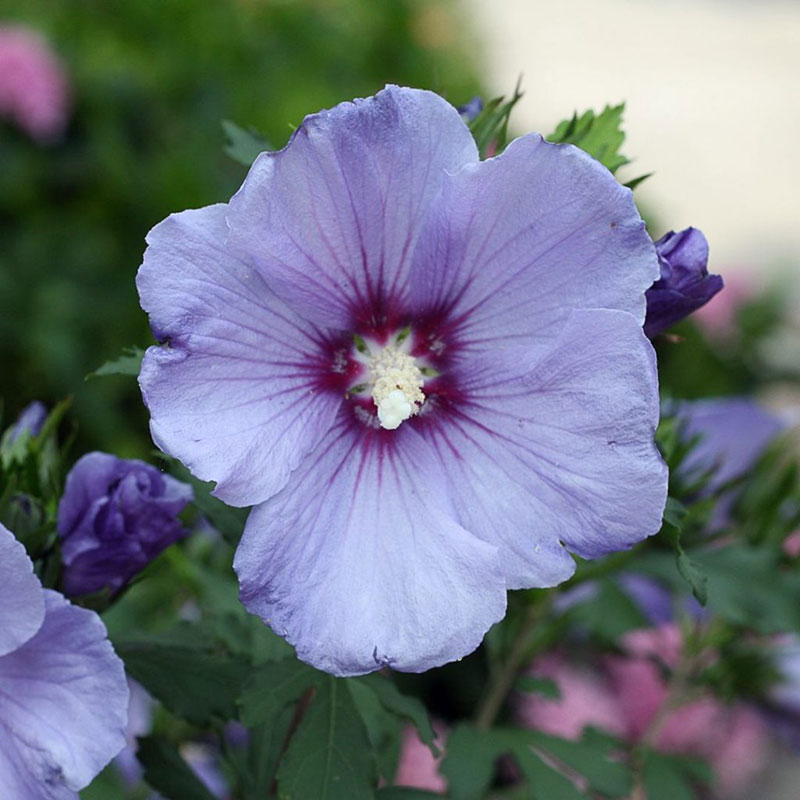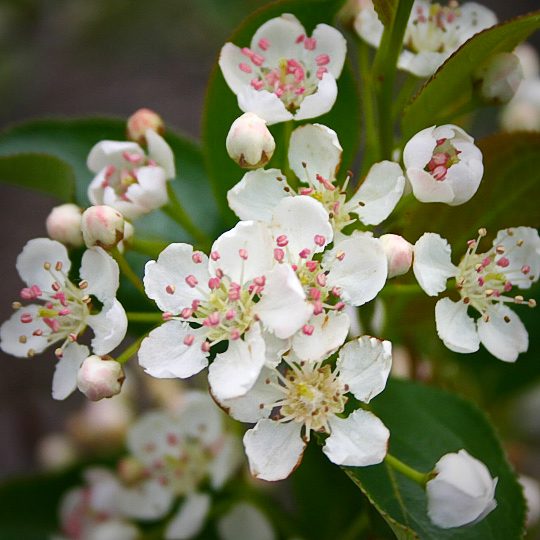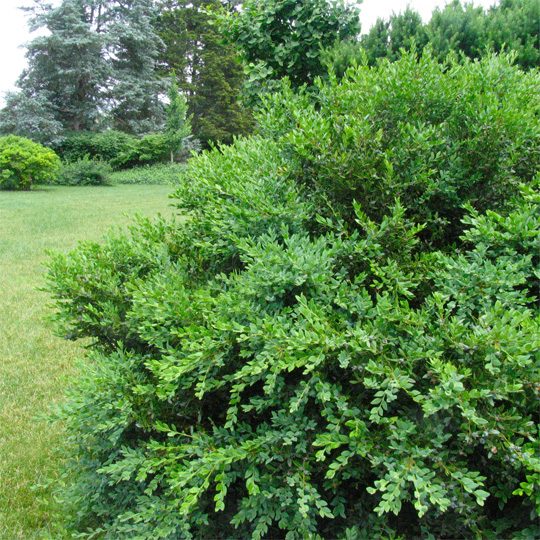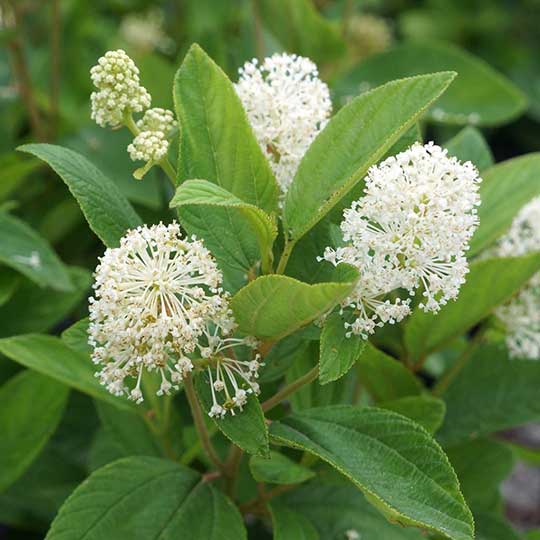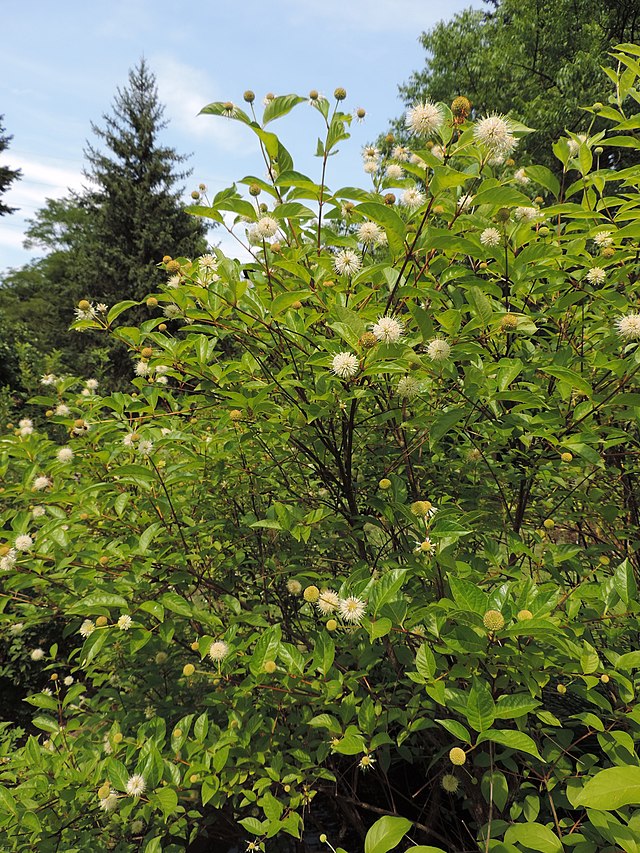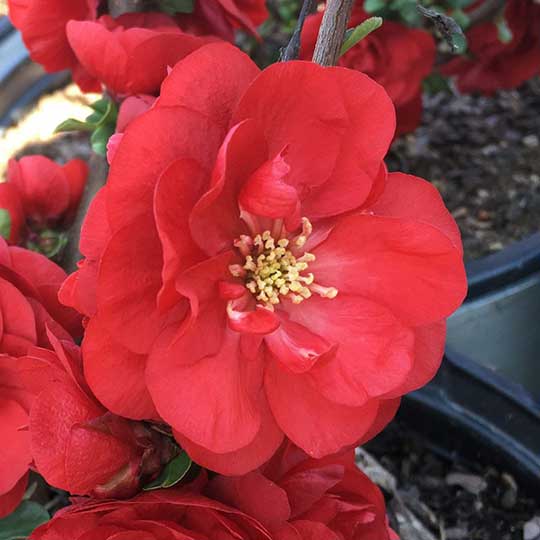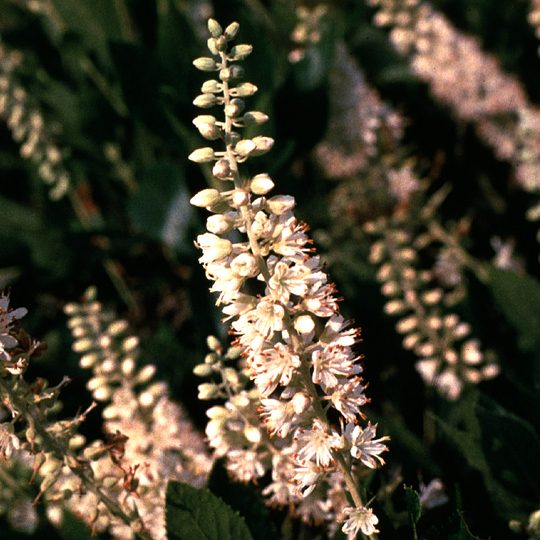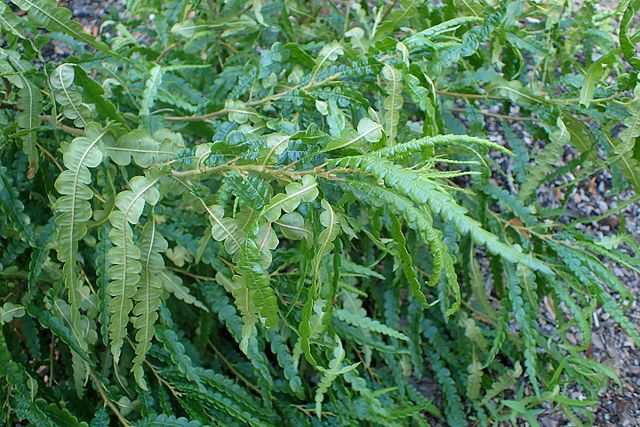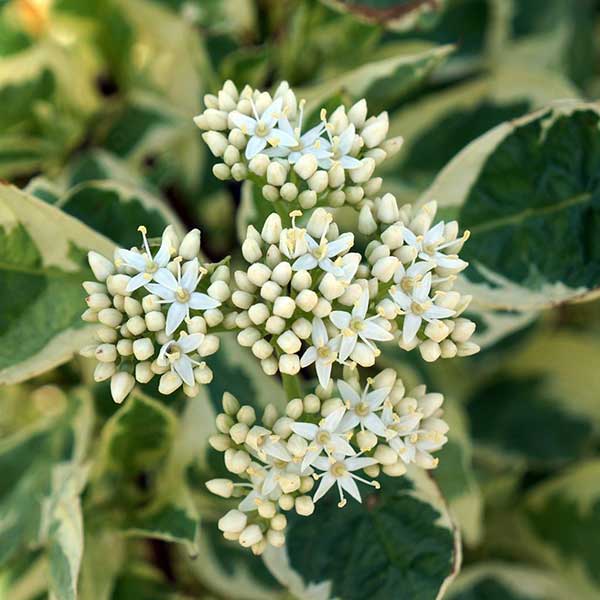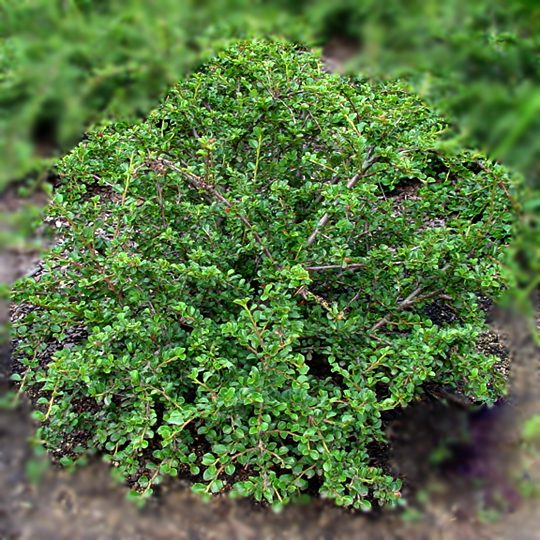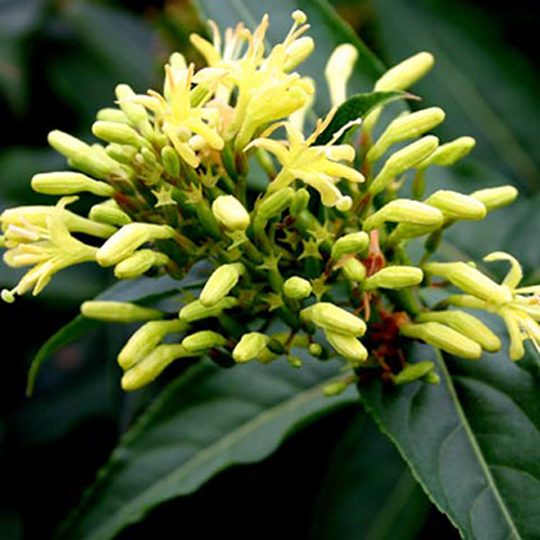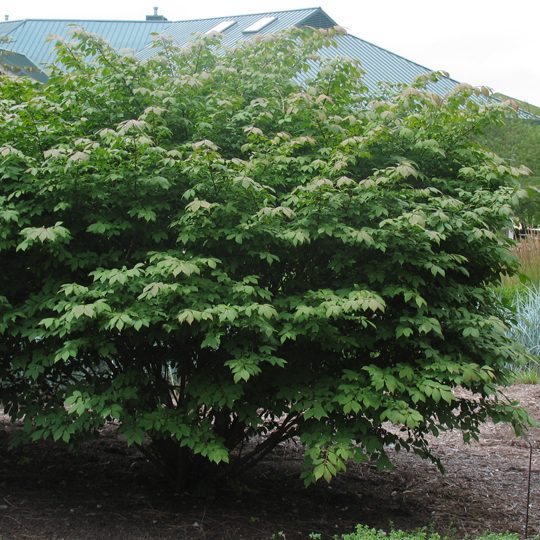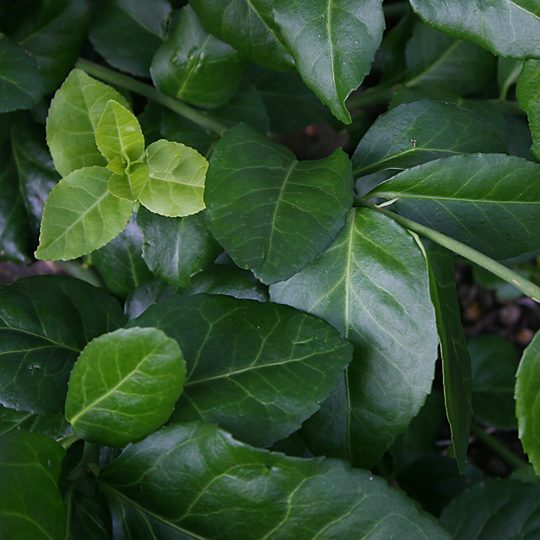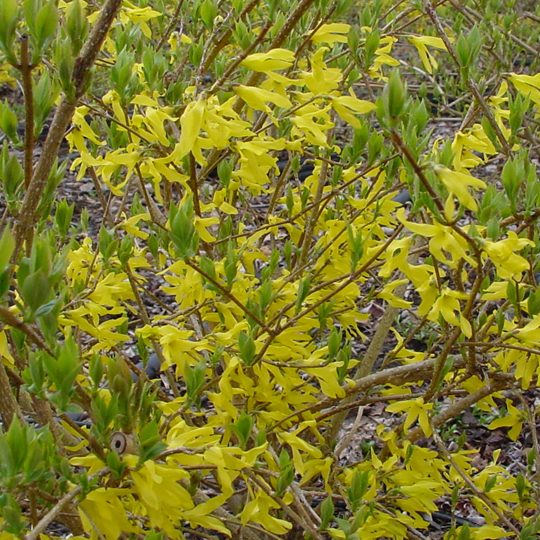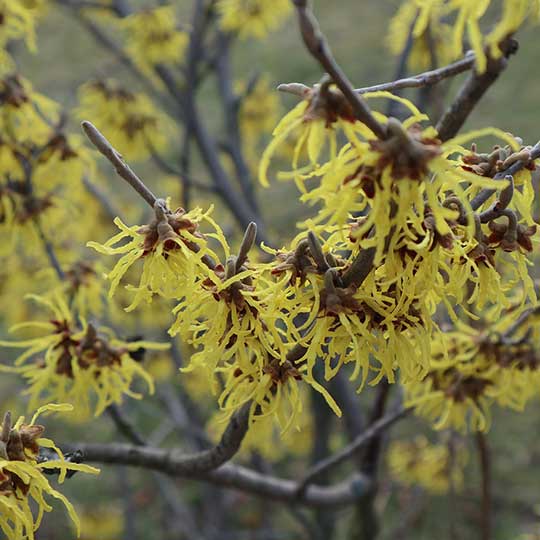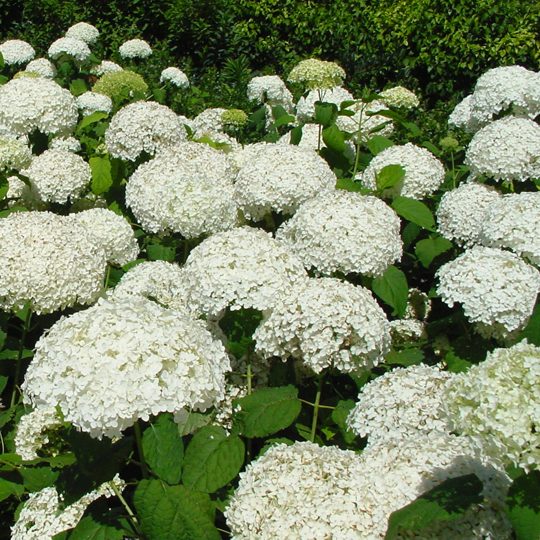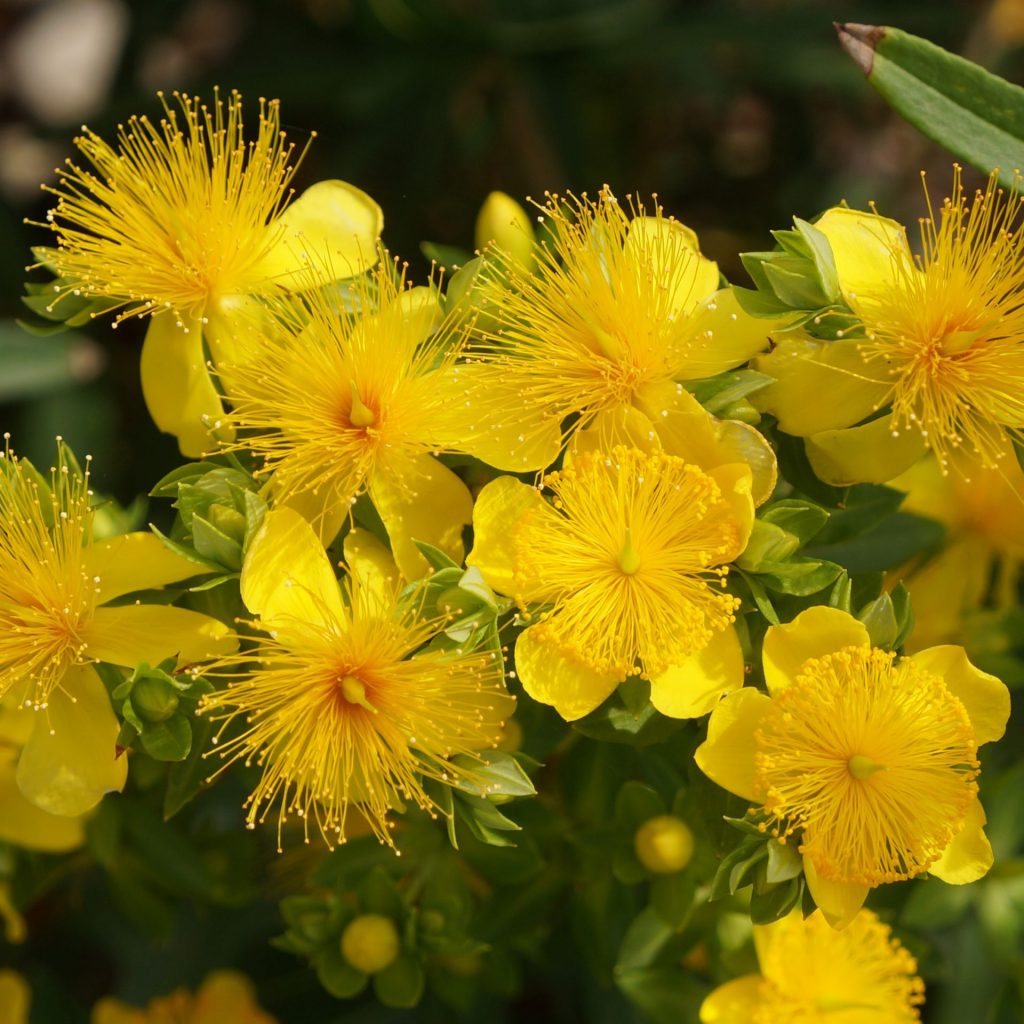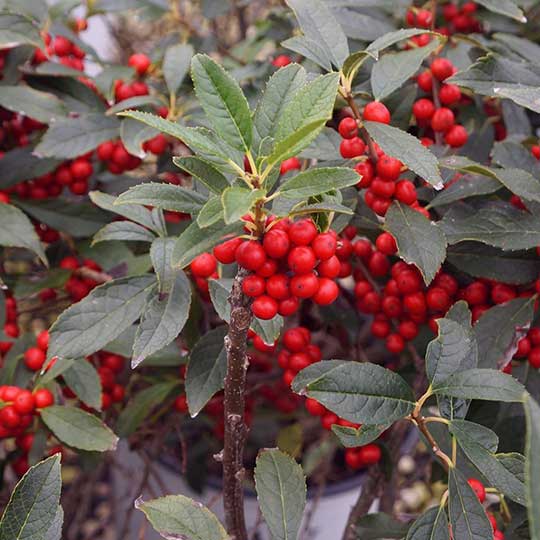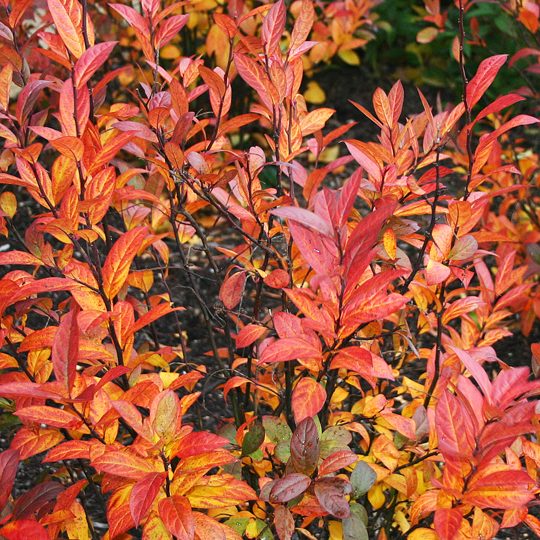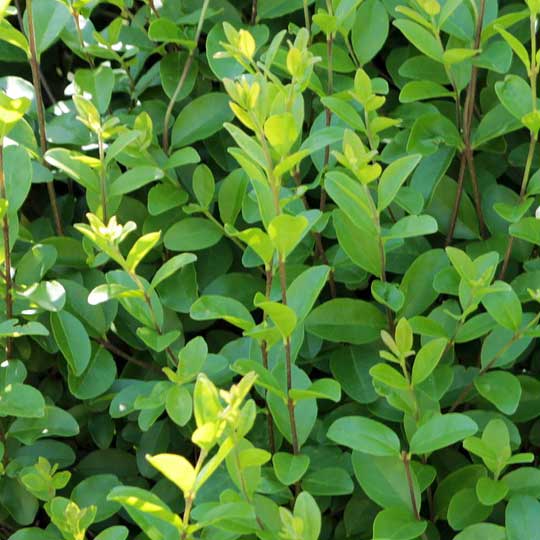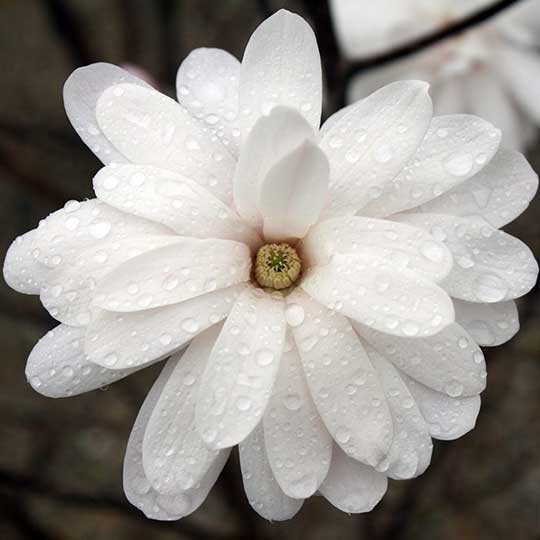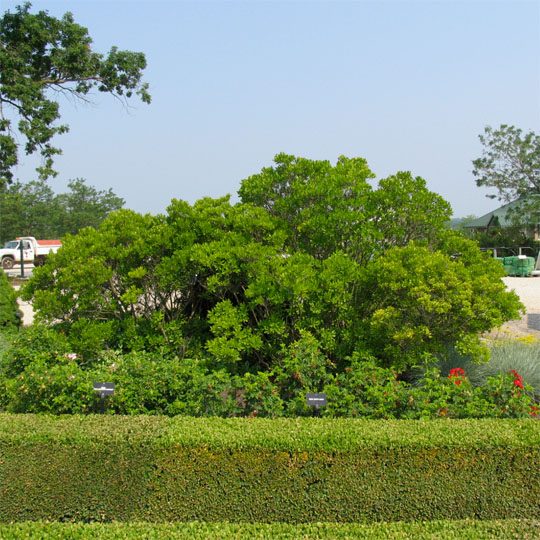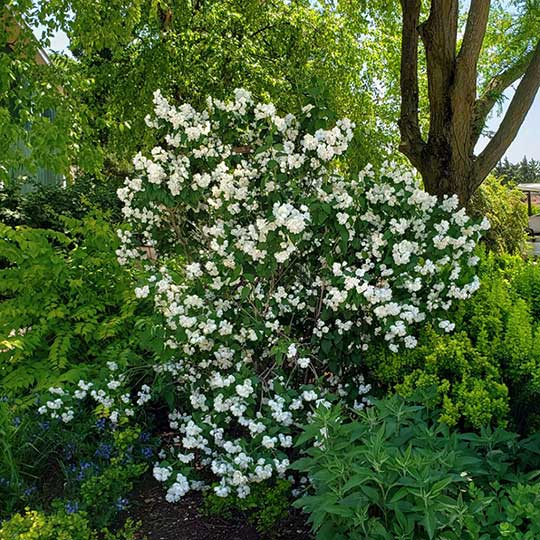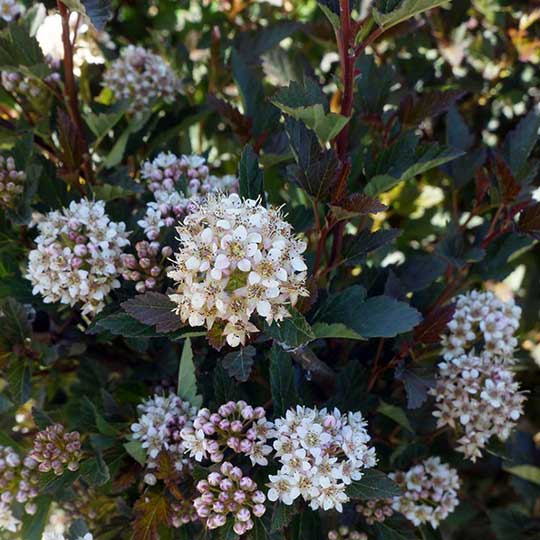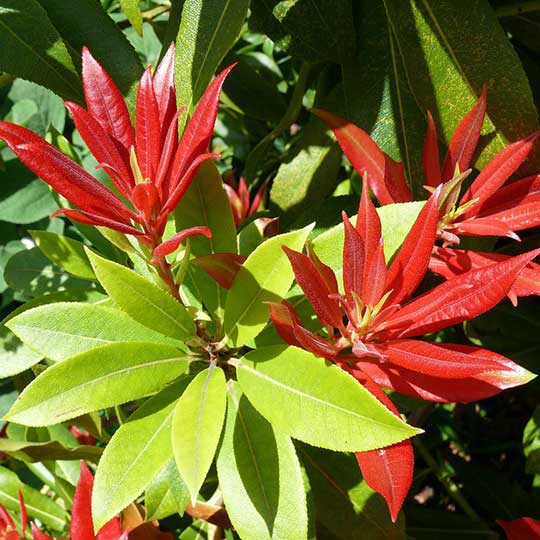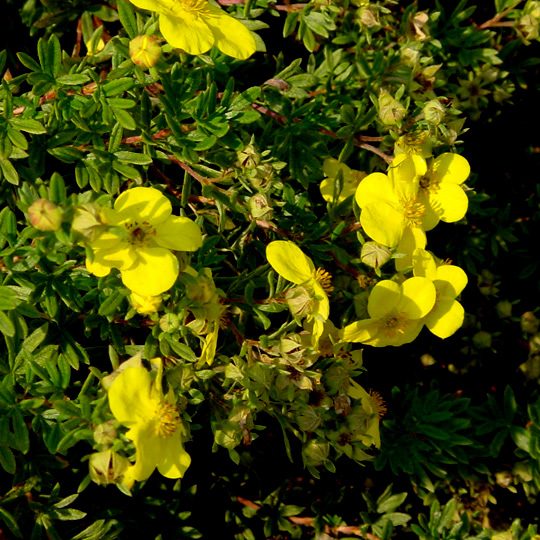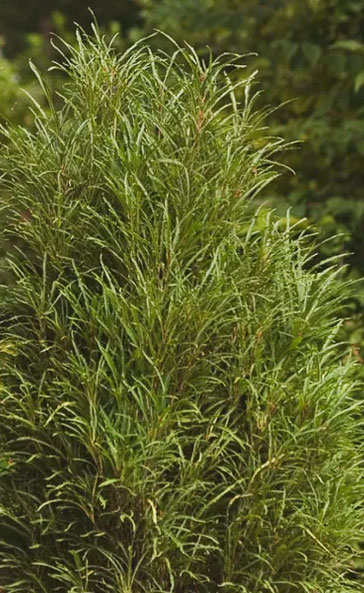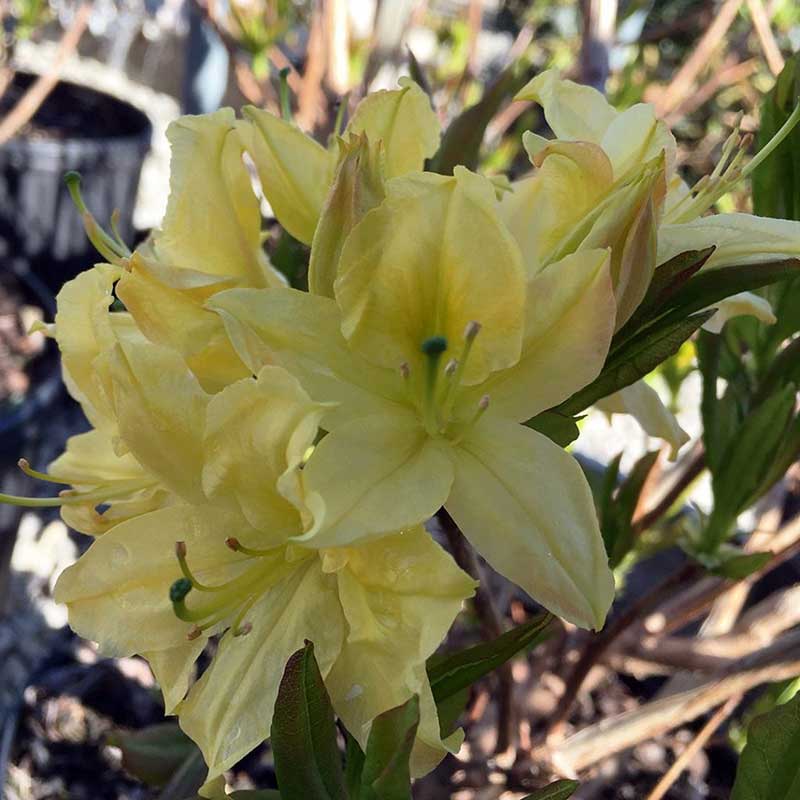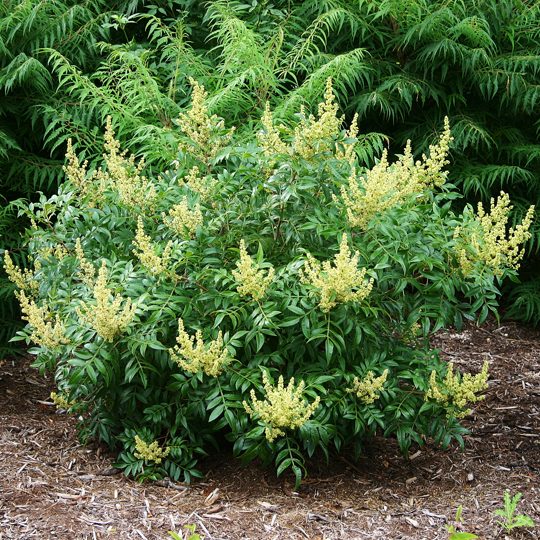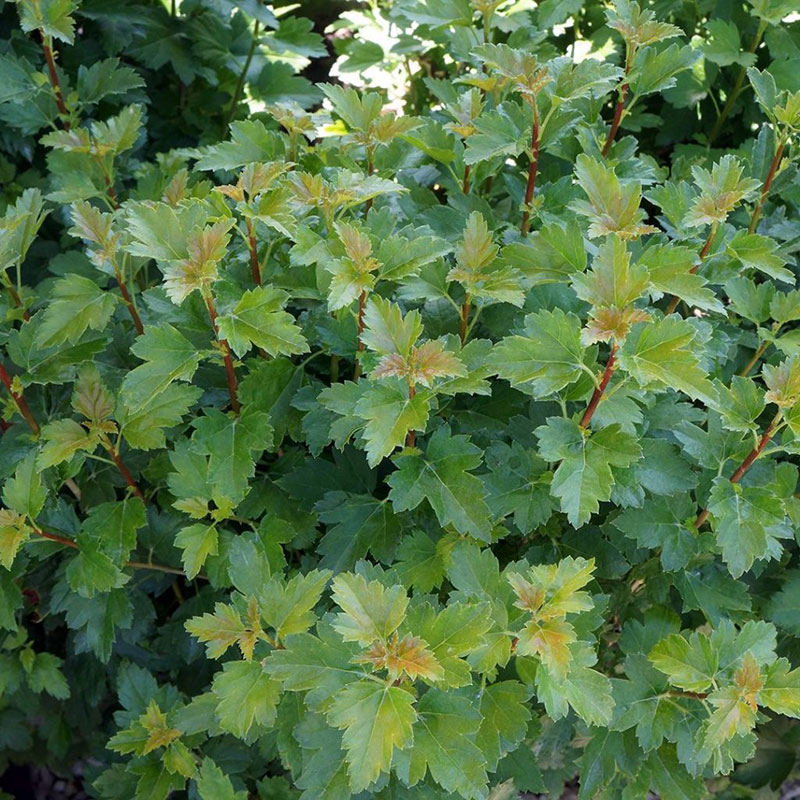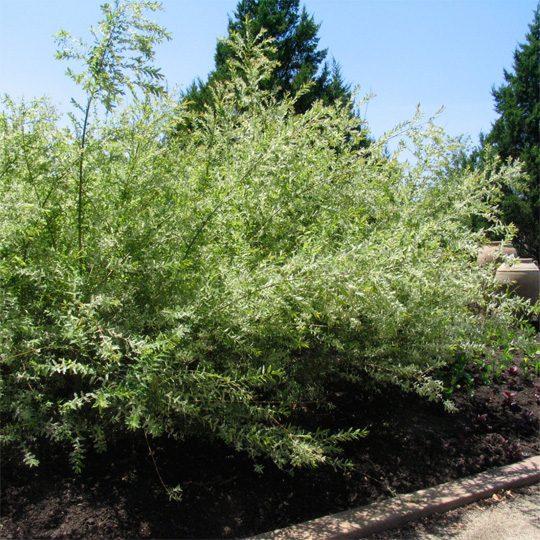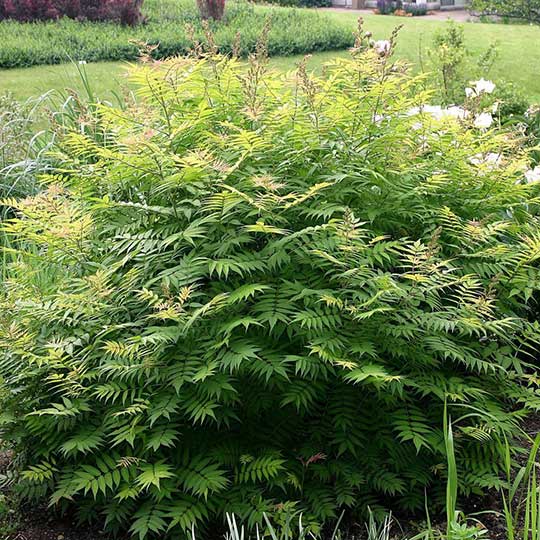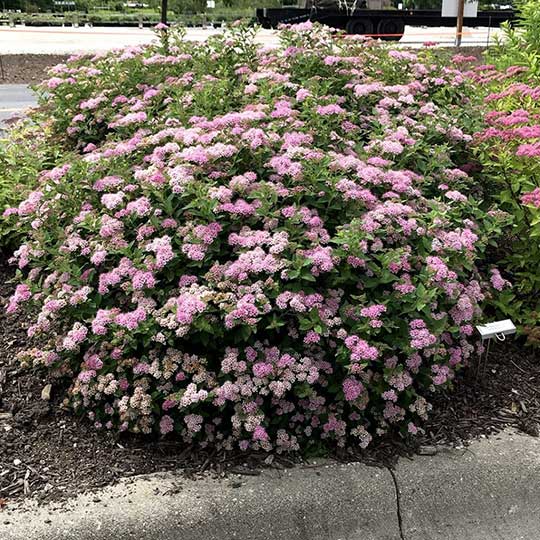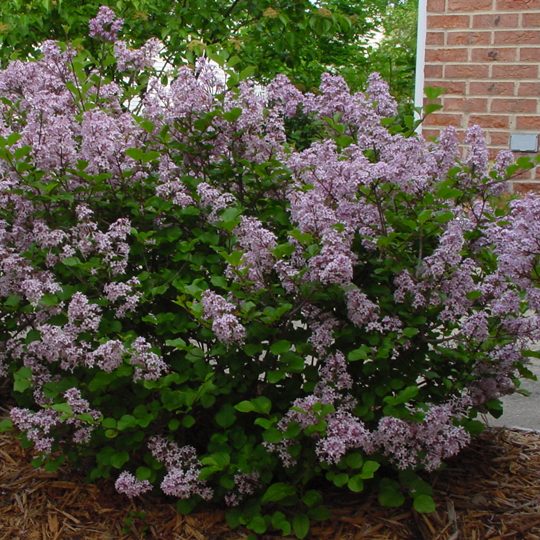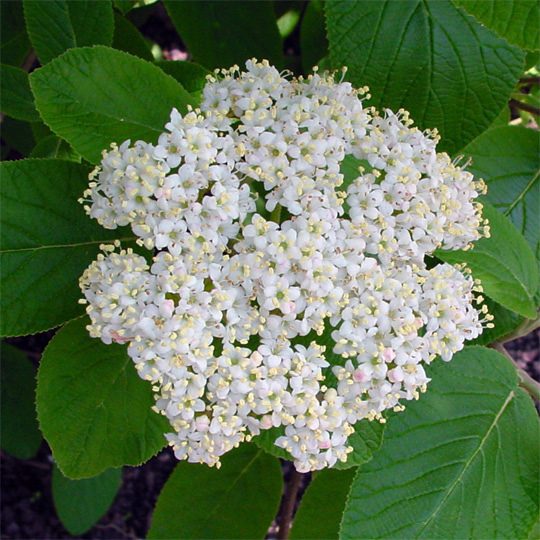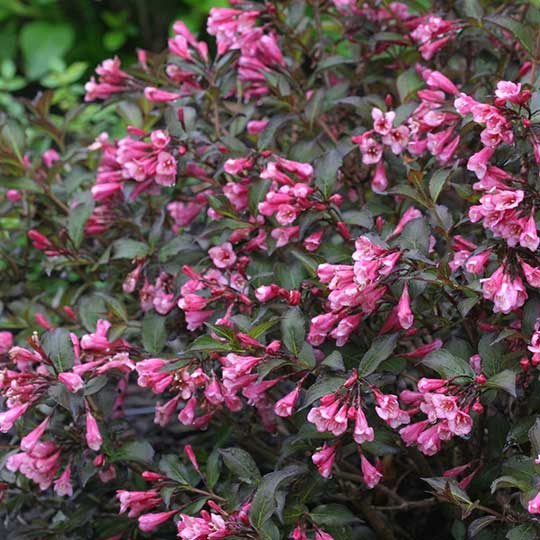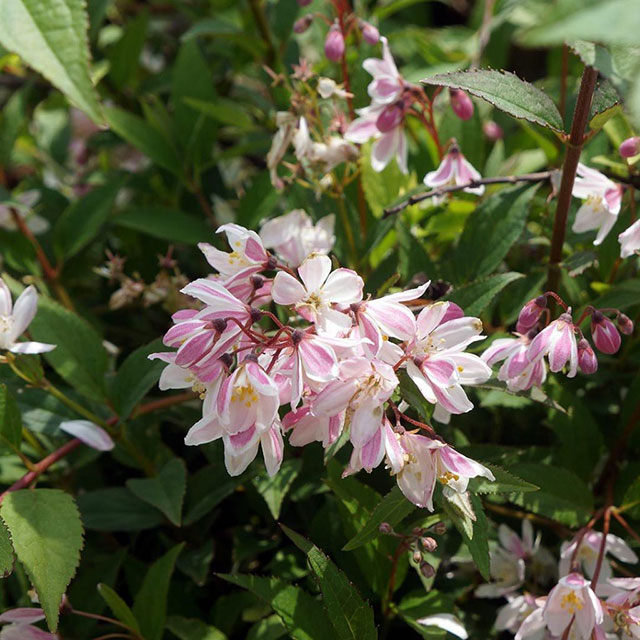shrubs and roses
Our shrubs and roses are sourced from top quality growers for Zone 5 gardens
Season opens from mid April – some shrubs and rose varieties listed here might not be available when you visit the nursery.
To easily navigate this page: click on a common name below for direct scrolling
A deciduous species of hibiscus that grows about one to two feet per year until mature height. These shrubs produce an abundance of flowers in late summer and early fall. There are many different varieties and colors available. They have an upright growing habit, often with multiple stems which can be cut to a single straight stem creating a tree like habit.
Height: 8′ – 12′
Width: 6′ – 8′
Watering and soil: Moist, well drained soil.
Exposure: Full sun is best.
Varieties: Magenta Chiffon, Purple Pillar, Ruffled Satin, Violet Paraplu, Minerva, Red Heart.
Image: Hibiscus syriacus ‘DVPAzurri’
aronia
Chokeberry
Deciduous shrubs that bears clusters of white or pink flowers in spring and berries thereafter. They do put on a good early season showing. Chokeberry prefer a well-drained moist soil, though they will survive in somewhat dry conditions. Chokeberry need to be pruned as they produce suckers which can become unwieldly. They generally do not attract many pests and diseases.
Height: 24″ – 36″
Width: 3′ – 4′
Watering and soil: Moist, well drained soil.
Exposure: Full sun is best.
Varieties: Ground Hug, Autumn Magic, Low Scape
Image: Iroquois Beauty™ Black Chokeberry
berberis
Barberry
Barberry are easy to grow deciduous shrubs requiring minimal care. They grow in average well drained soil but must not be over-watered. They are often used as hedges and are mound forming in habit. After winter, they sprout green leaves which start turning to shades of deep reds and purples and yellow in the fall. They do have thorns.
Height: 18″ – 24″
Width: 24″ – 36″
Watering and soil: Moist, well drained.
Exposure: Full sun.
Varieties: Crimson Pygmy, Golden, Rose Glow, Sunjoy Mini Saffron, Sunjoy Neo, Sunjoy Sequins.
Image: Crimson Pygmy Barberry
buxus
Boxwood
The boxwoods that we know are mainly evergreen shrubs. They are typically pruned into hedge shapes, but they don’t have to be. It’s important to plant boxwoods in well-drained soil as they do not like wet feet. Mulch is a useful addition as they have a shallow root system; this will prevent them from drying out. Fertilize in early spring with a general nitrogen rich formula like 10-6-4.
Height: 4′ – 6′ (dwarf varieties are smaller)
Width: 3′ – 4′
Watering and soil: Moist, well drained.
Exposure: Full sun is best.
Varieties: Green Gem, Green Mountain, Green Velvet, Northern Charm
Image: Green Mountain Boxwood
ceanothus americanus
New Jersey Tea – Mountain Snowbell
These North American native shrubs bear flowers in June and July. In addition to their delicate white blooms, they feature lush green leaves making them an attractive shrub for your landscape. Hummingbirds and butterflies love them. They do best in full sun and a dryish well drained soil. They do not like wet feet which will subject them to root rot.
Height: 3′ – 4′
Width: 3′ – 4′
Watering and soil: Dry, well drained.
Exposure: Full sun.
Varieties: New Jersey Tea
Image: Ceanothus americanus
Cephalanthus occidentalis ‘Sugar Shack’ is a dwarf variety of the buttonbush plant, native to North America. It’s a medium-sized shrub, with a garden height and spread of 48 to 60 inches. The plant is upright in habit and features white, creamy-colored flowers that bloom from early to mid-summer. The leaves are bright green.
These shrubs require part sun to sun for optimal growth. It’s best grown in well-drained, wet soils and is considered easy to maintain. It’s a favorite among bees, butterflies, and hummingbirds due to its fragrant flowers.
Height: 4′ – 6′
Width: 3′ – 4′
Watering and soil: Wet, well drained.
Exposure: Full sun is best.
Varieties: Sugar Shack
Image: Button Bush
chaenomeles
Flowering Quince
Flowering quince with their beautiful flowers is a member of the Rose family. These deciduous shrubs have a somewhat unwieldly growing habit – they have thorns. You will need to remove their suckers at ground level if you don’t want them to spread. They flower best in full sun and require an average well drained soil. They are fairly drought tolerant.
Height: 3′ – 4′
Width: 4′ – 6′
Watering and soil: Moist, well drained.
Exposure: Full sun.
Varieties: Orange Storm
Image: Chaenomeles speciosa ‘Scarlet Storm’
clethra
Summersweet
As their common name suggests, these shrubs produce beautiful scented flowers in summer. They are generally better suited for sun conditions, though they will perform quite well in more shade. Clethra do best in moist, well drained soils and flower from June through July. Their leaves turn golden yellow in fall.
Height: 3′ – 4′
Width: 2′ – 3′
Watering and soil: Moist, well drained.
Exposure: Full sun is best though they are shade tolerant.
Varieties: Hummingbird
Image: Clethra alnifolia ‘Sixteen Candles’
comptonia peregrina
Sweetfern
These aromatic shrubs are not actually ferns despite its name; they bring a touch of the wildlands to your garden.
Native to eastern North America, these shrubs thrive in dry, sandy, or gravelly soils, making it a valuable choice for areas other plants struggle in.
Height: 2′ – 4′
Width: 4′ – 8′
Watering and soil: Poor dry soil.
Exposure: Full sun to part shade.
cornus
Dogwood
Dogwood are mounded deciduous shrubs that can grow up to 6 foot tall – some varieties have variegated leaves. They are a landscape and garden favorite with many attractive features. They require average soil and do best in full sun. Dogwood are susceptible to disease, especially in late summer, and may require care. They flower May through June.
Height: 4′ – 6′
Width: 4′ – 6′
Watering and soil: Moist, well drained.
Exposure: Full sun.
Varieties: Ivory Halo, Neon Burst, Radiant Rose, Summer Gold
Image: Cornus alba ‘Bailhalo’
cotinus
Smokebush
Smokebush are larger deciduous shrubs prized mainly for its beautiful leaf structure and color. These shrubs make excellent specimen plants especially in fall. Once established, they are drought tolerant requiring only an average soil. Plant these shrubs in full sun. Feed in spring with a nitrogen rich fertilizer to promote leaf growth.
Height: 8′ – 12′
Width: 8′ – 12′
Watering and soil: Moist at first, well drained.
Exposure: Full sun.
Varieties: Gold Spirit, Royal Purple, Winecraft Black.
Image: Cotinus coggygria ‘Royal Purple’
cotoneaster
Once established, Cotoneaster are drought tolerant shrubs. They have a herringbone branch structure and produce beautiful bright berries in late summer. They have small leaves turning golden shades in fall. They are not fussy about soil requirements and do not need a lot of fertilizer.
Height: 2′ – 3′
Width: 3′ – 4′
Watering and soil: Moist, well drained to establish, then dry tolerant.
Exposure: Full sun.
Varieties: Hessei. Peking (grows 6′ – 8′)
Image: Cotoneaster ‘Hessei’
diervilla
Bush Honeysuckle
Diervilla are smallish shrubs that have clusters of flowers from April through June. They are not fussy and are tolerant of poor infertile soils. They are also prized for their dense foliage – starting out green and turning yellow, orange and red moving towards fall. They can take some shade but will perform better in full sun.
Height: 3′ – 4′
Width: 3′ – 4′
Watering and soil: Well drained infertile soil.
Exposure: Full sun is best.
Varieties: Bush Black, Bush Butterfly, Bush Niteglow, Bush Orange, Bush Red, Cool splash
Image: Diervilla sessilifolia ‘Butterfly’
euonymus alatus
Dwarf Burning Bush
Euonymus alatus is particularly prized for its spectacular fall color. These shrubs are often grown as a hedge but do make spectacular specimen shrubs. The flowers are largely insignificant which are replaced by purplish red fruits that mature during the fall. These plants do best in full sun but will tolerate some light shade.
Height: 6′ – 8′ (dwarf varieties are smaller)
Width: 6′ – 8′
Watering and soil: Moist, well drained.
Exposure: Full sun is best.
Varieties: Dwarf Burning Bush
Image: Dwarf Burning Bush
euonymus fortunei
Wintercreeper
The Euonymus fortunei species, commonly known as Wintergreen, are low growing broadleaf evergreen shrubs. Their flowers are insignificant and are typically used for the different colors of leaf varieties. They are very useful as edging plants and massed along slopes or beds.
Height: 3′ – 4′ (dwarf varieties are smaller)
Width: 4′ – 6′
Watering and soil: Moist, well drained.
Exposure: Full sun to part shade.
Varieties: Sarcoxie, Emerald Gaiety, Emerald ‘N Gold, Gold Splash.
Image: Euonymus fortunei ‘Sarcoxie’
forsythia
Forsythia are arching, evergreen deciduous shrubs that are commonly seen around the Chicagoland area. Few plants herald the onset of the coming summer like the proliferous early blooming yellow Forsythia flowers. In most gardens they are pruned as a hedge which negates their long arching stems. They are not fussy shrubs and grow fast.
Height: 4′ – 10′
Width: 4′ – 6′
Watering and soil: Moist, well drained. Dry tolerant.
Exposure: Full sun to part shade.
Varieties: New Hampshire Gold, Show Off
Image: Forsythia x intermedia ‘New Hampshire Gold’
hamamelis
Witch Hazel
Witch Hazel are low maintenance, hardy shrubs. The virginiana varieties flower in winter, which makes them particularly attractive for seasonal interest. The flowers are also fragrant. They do best in a well-drained moist loamy soil in full sunlight. A slow release fertilizer can be applied a couple of times during the summer.
Height: 8′ – 10′
Width: 8′ – 10′
Watering and soil: Moist, well drained.
Exposure: Full sun to part shade.
Varieties: Red
Image: Witch Hazel
hydrangea
Macrophylla – Paniculata – Arborescens – Quercifolia
There are many species and varieties of these popular shrubs. They come in a wide variety of colors and patterns. They are best planted in early spring or fall to ensure their shallow root system has enough time to establish. Hydrangeas should be planted in a good, well-drained soil. Ensure they always have plenty of water to drink especially on the scorching hot summer days.
Height: 3′ – 6′
Width: 4′ – 6′
Watering and soil: Moist, well drained.
Exposure: Full sun to part shade.
Varieties: Annabelle, Bobo, Endless Summer, Fire Lite, Incrediball, Quick Fire, Little Lime, Moonrock, Strawberry Sundae, Zinfin Doll, Blue Jangles Let’s Dance, Paris Rapa, Invincibelle Wee White, L. A. Dreamin’, Big Band Let’s Dance, Can Do Let’s Dance, Rave Let’s Dance.
Image: Hydrangea arborescens ‘Annabelle’
hypericum
St Johnswort
The first thing you notice about these shrubs when they are in flower are their showy stamens. They are easy to grow in a variety of different conditions. They do need to be controlled when they’re established and do best in full sun. Hypericum require a lot of watering when first establishing, thereafter, they are fairly dry tolerant.
Height: 2′ – 3′
Width: 2′ – 3′
Watering and soil: Moist, well drained.
Exposure: Full sun.
Varieties: Ames, Blues Fest, Gemo
Image: Hypericum kalmianum ‘Ames’
ilex
Winterberry – Holly
Winterberry holly are deciduous shrubs native to the eastern US. Their bright red berries last throughout winter into spring. They are dioecious, meaning there needs to be a male and female plant for pollination to produce berries. Winterberries are wetland plants and need a moist soil to thrive. A balanced 10-10-10 fertilizer can be applied in spring but is not necessary.
Height: 3′ – 4′
Width: 3′ – 4′
Watering and soil: Moist, wet soil.
Exposure: Sun to part shade (four hours sun minimum).
Varieties: Berry Poppin, Mr Poppin
Image: Ilex verticillata ‘FarrowBPop’
itea
Sweetspire
Sweet Spire are deciduous shrubs native to eastern North America. They are beautiful in fall when their leaves turn orange, red and gold. They require average to well-drained soil and are easy to grow. They do best planted in full sun and won’t flower as well under shady conditions. Though not necessary, you can feed them with a well-balanced fertilizer in early spring. They flower mid spring to early summer.
Height: 3′ – 6′
Width: 3′ – 6′
Watering and soil: Moist, well drained.
Exposure: Full sun.
Varieties: Little Henry, Scentlandia, Scarlet Beauty
Image: Itea virginica fall colors.
ligustrum
Privet
If you are looking for a classic hedge, look no further than a privet. They do have small panicle like flowers which bloom in early summer, but we typically don’t see them due to heavy pruning. Privet will grow in poor quality well drained soil. They can also tolerate a fair amount of dappled shade. Apply a nitrogen rich fertilizer in early spring.
Height: 4′ – 15′
Width: 4′ – 10′
Watering and soil: Moist, well drained.
Exposure: Full sun to part shade.
Varieties: Cheyenne
Image: Ligustrum
magnolia
As an early to mid-spring specimen plant, not much beats the splendor of Magnolia flowers. Magnolias are best grown in full sun to part shade in well drained soils. The soils don’t have to be rich in quality, but they must drain well for them to grow healthily.
They make fantastic specimen plants. They are best pruned in midsummer when in full leaf.
Height: 10′ – 20′
Width: 8′ – 15′
Watering and soil: Moist, well drained.
Exposure: Full sun to part shade.
Varieties: Royal Star (white), Jane (pink), Leonard Messel (white-pink).
Image: Magnolia stellata ‘Royal Star’
Myrica pensylvanica
Northern Bayberry
Northern bayberry are native to the eastern US. They are dioecious shrubs meaning that only male and female flowers appear on each plant – you would have to have a male and female plant for pollination. They are not fussy plants and will grow in dry poor soil conditions. They spread by root suckers creating colonies and control will be necessary.
Height: 8′ – 12′
Width: 8′ – 12′
Watering and soil: Moist, well drained.
Exposure: Full sun to part shade.
Varieties: Northern Bayberry
Image: Northern Bayberry
philadelphus
Mock Orange
Loved by gardeners for their late spring, early summer citrus fragrance. Pollinators love them too as they are rich with nectar. These deciduous shrubs have a quick growth rate of about 2 feet per year. They must have good drainage, as they cannot tolerate being waterlogged. They require on average 4 hours of sunlight a day. Feed with a nitrogen light fertilizer to avoid excessive leaf growth which can hinder blossom development.
Height: 4′ – 6′
Width: 4′ – 6′
Watering and soil: Moist, well drained.
Exposure: Full sun to part shade.
Varieties: Illuminati Tower, Snow White.
Image: Philadelphus ‘Snow White Fantasy’
physocarpus opulifolius
Ninebark
Ninebark gets its name from its exfoliating bark and is a very popular landscaping plant. It flowers in late spring. Many cultivars are available and are used for foundation planting, hedges and screens. These shrubs require minimal care, can tolerate poor soils and drought conditions. Ideally they should be situated in full sun to promote maximum flowering.
Height: 3′ -4′
Width: 3′ – 4′
Watering and soil: Moist, well drained.
Exposure: Full sun (for best flowering) to part shade.
Varieties: Ginger Wine, Lemon Candy, Panther, Summer wine
Image: ‘Little Devil’
pieris
Mountain Fire
Pieris are beautiful shrubs. New growth starts out as a fiery red and turns into an evergreen foliage. They have profuse clusters of white flowers and look superb in spring. They will need some winter protection in our area. They are slow growers and prefer a filtered sun or partial shade. A worthwhile choice for the more discerning gardener.
Height: 6′ -10′
Width: 6′ – 10′
Watering and soil: Moist, well drained.
Exposure: Filtered sun, part shade.
Varieties: Mountain Fire
Image: Mountain Fire
potentilla
Cinquefoil
Potentilla shrubs, with their dainty flowers are a member of the Rose family. They bloom profusely from June through September. As long as they have well-draining soil, they are adaptable to many soil types. They will flower best if planted in full sun. An all-purpose fertilizer can be applied in early spring.
Height: 3′ – 4′
Width: 3′ – 4′
Watering and soil: Moist, well drained.
Exposure: Full sun.
Varieties: Jackmanii, Bella Sol, Happy Face Yellow.
Image: Potentilla fruticosa ‘Jackmanii’
rhamnus frangula
Fine Line Buckthorn
Unlike other Buckthorn varieties known for their aggressive spread, Fine Line Buckthorn produces very few fruit, and among those, only a tiny fraction (2%) are even viable.
This makes it a responsible choice for gardeners concerned about invasive plants and ecological balance.
Height: 5′ – 7′
Width: 2′ – 3′
Watering and soil: Dry tolerant when established.
Exposure: Full sun is best.
rhododendron
Rhododendron – Azalea
With the right care, Azaleas can last you decades. They require an acidic soil – PH 5 to 5.5. They provide an exceptional display of flowers in April and May. These shrubs prefer a well-drained moist soil in a slightly shaded position. The soil can be amended with peat moss, pine needles, or an acidifying fertilizer. Prune after flowering as new flowering takes place on old wood the following season.
Height: 4′ – 6′
Width: 3′ – 4′
Watering and soil: Moist, well drained acidic soil.
Exposure: Lightly shaded to sun.
Varieties: Lemon Lights, Mandarin Lights, Karen, Purple, P.J.M, Purple, Purple Gem, Red, White.
Image: Rhododendron ‘Lemon Lights’
rhus
Sumac – Prairie Flame
This variety of Sumac, Prairie Flame, is outstanding for embankment stabilization due to its strong root structure. They are dioecious shrubs – you need both male and female plants for pollination. They are an excellent food source for local wildlife. Sumac are native to the eastern United States. They are drought and salt tolerant once established.
Height: 4′ – 6′
Width: 4′ – 6′
Watering and soil: Dry soil.
Exposure: Sun to part shade.
Varieties: Prairie Flame
Image: Rhus copallina var. latifolia ‘Morton’
ribes
Alpine Currant
These shrubs are excellent for hedging. They have a mounding habit and grow up to six feet tall. Alpine currant flowers are insignificant. A feature is the changing color of their leaves which start bright green in the beginning of the season to a warm yellow by fall. If you are looking for a foliage shrub, this is an excellent choice.
Height: 4′ – 6′
Width: 4′ – 6′
Watering and soil: Moist, well drained soil.
Exposure: Full sun is best.
Varieties: Europa, Ground Mound
Image: Ribes alpinum ‘Europa’
rosa
Rose
Roses need full sun, at least six hours or more is recommended. Roses are heavy feeders, and a rich loam is best. Fertilize them from early spring after the first buds appear to mid-August – feed about every 8 to 12 weeks. Apply about 2 inches of mulch around the shrub. Roses are susceptible to disease and bug infestations – it is better to treat them before the problems arise.
Height: 3′ – 4′
Width: 3′ – 4′
Watering and soil: Moist, well drained rich soil.
Exposure: Full sun is best.
Varieties: Carpet Pink Supreme, Carpet Red, Drift Red, Knock Out Roses, Pavement Hansa, Raspberry Rugostar, Sunrise Sunset, Climbing Multicolor, Climbing Red, Climbing Yellow, Hybrid Tea Lavender, Hybrid Tea Multicolor, Hybrid Tea Red, Hybrid Tea White, Hybrid Tea Yellow, Oso Easy Double Red, Oso Easy Lemon Zest, Oso Easy Paprika, Peach Lemonade.
Image: Rosa ‘Radral’
salix
Dappled Willow
Shrub willows are ideal for moist and wet areas of the garden. The Salix integra or dappled willow in particular, can make a fine specimen plant. They can tolerate some light shade too. In addition to moisture, they like rich organic material. If they are planted in a drier bed, particularly during the dry summer heat, deep water weekly and apply at least two inches of mulch.
Height: 4′ – 6′
Width: 4′ – 6′
Watering and soil: Moist to wet rich soil.
Exposure: Full sun, part shade.
Varieties: Blu Nana, Hakuro Nishiki, Pussy French Pink
Image: Salix integra ‘Hakuro-nishiki’
sorbaria
False Spirea
Sorbaria shrubs have beautiful leaves with different shades of greens and pastel colors. They also have spikes of white flowers, especially when grown in full sun. They can, however, be planted in semi shade – two to six hours of sun a day. They colonize by way of root suckers and do need to be controlled. The ‘Sem’ variety is a smaller Sorbaria shrub.
Height: 3′ – 4′
Width: 4′ – 6′
Watering and soil: Moist, well drained rich soil.
Exposure: Full sun is best.
Varieties: Cherry Top, Sem
Image: Sorbaria sorbifolia ‘Sem’
spirea
Spirea has established itself as a prime garden favorite. The showy clusters of delicate flowers in June and July can be spectacular when planted in the right location. They flower best in full sun and are generally carefree, low maintenance plants. Pollinators love them too. Keep them well watered in well-drained soil after planting. They only require watering thereafter when it’s very dry.
Height: 2′ – 3′
Width: 2′ – 3′
Watering and soil: Moist, well drained soil.
Exposure: Full sun is best.
Varieties: Blue Kazoo, Play Doozie, Glow Girl, GoldMound, Goldflame, Magic Carpet, Renaissance, Shirobana, Snowmound
Image: Spiraea japonica ‘Little Princess’
syringa
Lilac
Prized for their scent, lilac shrubs need at least six hours of sunlight a day to produce great flowers. They will grow in shadier locations but won’t flower as well. They need a moist, well-drained soil and require very little fertilizer.
Height: 4′ – 6′
Width: 6′ – 8′
Watering and soil: Moist, well drained soil.
Exposure: At least 6 hours of sun.
Varieties: Common White, James MacFarlane, Korean Dwarf, Ludwig Spaeth, Miss Canada, Miss Kim, Persian, Baby Kim, Bloomerang Dwarf Purple, Monge (Red-Purple), Scentara Pura Purple, Sensation (Bicolor).
Image: Syringa meyeri ‘Palibin’ (Dwarf Korean)
viburnum
Viburnum is a very popular shrub with many choices available. They can grow from 4 feet to as tall as 20 feet, some will even do well in part shade. Although viburnums are monoecius they will need another variety to cross pollinate to produce berries (they are self-incompatible). They should have well drained soil as they do not like wet feet. They are easy to grow and require no more than a balanced fertilizer in spring.
Height: 4′ – 18′
Width: 6′ – 10′
Watering and soil: Moist, well drained soil.
Exposure: Full sun is best.
Varieties: Cranberry, Blue Muffin, Juddi, Korean Spice, Lantana Mohican, Red Wings, Common Snowball, Red Feather.
Image: Viburnum lantana ‘Mohican’
weigela
Weigela shrubs are a member of the honeysuckle family – hummingbirds and butterflies love them. They flower during May and June and can make excellent specimen plants. They are also useful for hedging. They’re generally not fussy and easy to grow; full sunlight is a must. They need deep watering as they’re getting established, thereafter they are drought and dry tolerant.
Height: 3′ – 4′
Width: 3′ – 4′
Watering and soil: Moist, well drained soil until established.
Exposure: Full sun.
Varieties: Midnight Wine Shine, My Monet, Snippet Dark Pink, Pearl Sonic Bloom, Wine Sonic Bloom, Florida Wine and Roses, Spilled Wine, Very Fine Wine, Lemon Ice.
Image: Weigela florida ‘Bramwell’ – Fine wine
yuki cherry blossom
Deutzia ‘Yuki Cherry Blossom’ is a dwarf Deutzia shrub that is known for its beautiful display of pink flowers in the spring. It is a low-growing plant that typically stands between 12 and 24 inches high
Height: 1′ – 2′
Width: 1′ – 2′
Watering and soil: Fertile, well drained.
Exposure: Full sun with afternoon shade is best.
Image: Yuki Cherry Blossom.

